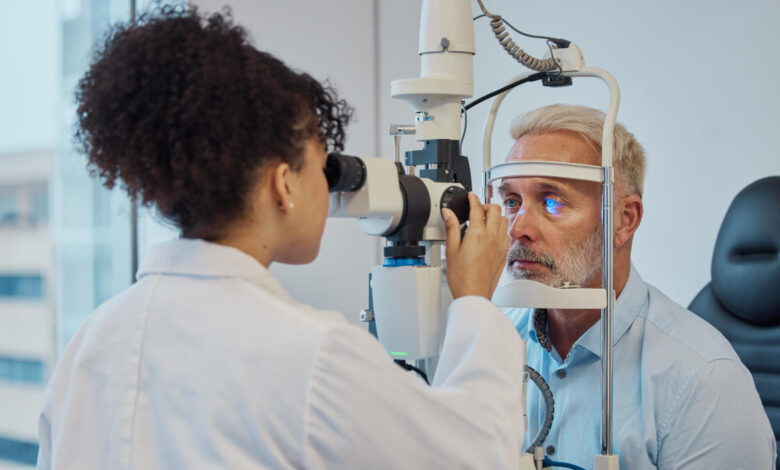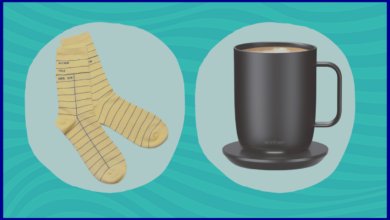Semaglutide is linked to a rare eye condition that can cause blindness. Don’t be alarmed, doctors say.

Semaglutide, the active ingredient in Ozempic and Wegovy, has become a hugely popular medication thanks to its effectiveness for weight loss. But a growing body of research has linked the medication to some serious side effects, including pancreatitis, an inflammation of the pancreas, and gastroparesis, a paralysis of the stomach. Now there’s a new concern to add to the list: It may raise your risk of developing a blinding eye condition.
That’s the major takeaway from a new study published in JAMA Ophthalmology. For the study, researchers analyzed medical records of more than 17,000 patients at Mass Eye and Ear who were treated over six years since the release of Ozempic. Patients were divided into those who were diagnosed with diabetes and those who had overweight or obesity. Patients who took semaglutide for these conditions were compared to ones on other diabetes or weight loss medications.
Researchers then analyzed the rate of patients diagnosed with NAION, a rare condition that is the second-leading cause of optic nerve blindness. NAION is believed to be caused by reduced blood flow to the optic nerve head. It can lead to permanent visual loss in one eye that may develop painlessly and suddenly or over several days before it stabilizes. There are currently no effective treatments for NAION.
After analyzing the data, the researchers found that people with diabetes who used semaglutide were more than four times more likely to be diagnosed with NAION. The rates for people who were overweight or obese were seven times more likely to be diagnosed with NAION.
It’s certainly understandable that those on semaglutide would be worried. So Yahoo Life asked eye specialist to break down how concerning the risk is, along with what you can do to stay on top of your eye health if you use semaglutide.
How concerning is this?
It’s important to make a few caveats. One is that Mass Eye and Ear is a specialized eye institute that sees a high number of people with rare eye diseases, so the population may have been a little skewed. Another is that the researchers couldn’t tell if the patients actually took the medication or if they filled the prescription and stopped taking it at some point (which may or may not have affected their risk).
That said, there does seem to be a connection here — it’s just not clear why. “We didn’t do the study because we had any anticipation that the drug would cause this disease,” Dr. Joseph Rizzo, the primary study investigator and director of neuro-ophthalmology service at Mass Eye and Ear, tells Yahoo Life. “We did it because we saw a number of cases of NAION in close succession. That seemed unusual to us.”
Semaglutide has “multiple mechanisms of action,” Rizzo says, and adds that there are “some clues about why this might cause NAION, but we don’t know right now.” NAION is caused by a stroke of the optic nerve, which makes it tricky to prevent. “For the most part, it just happens, and once it happens, that’s it,” he says.
However, doctors aren’t worried just yet. “Any medication you take has an increased risk of side effects,” Bavand Youssefzadeh, an ophthalmologist in Beverly Hills, Calif., tells Yahoo Life. “Patients who take these medications already have diabetes or overweight, so they’re already at an increased risk for eye disease.”
Youssefzadeh stresses that NAOIN is “still very rare,” although it is common for people to notice vision changes when they lose weight or stabilize their blood sugar with semaglutide. “If you have a change in weight, or you have high or low blood sugar, your eye’s lens will change shape,” Youssefzadeh says.
Rizzo points out that his study did not show cause and effect — it just found a link. “Hopefully, it will prompt a much larger study to examine whether there’s cause and effect,” he says.
He believes that “extra information in medicine is helpful, and the more you understand about something, the better you are.” The study’s findings are “information that we didn’t have previously.” As a result, Rizzo says that “it at least should be taken into consideration as a risk-to-benefit analysis by a patient.”
Semaglutide may also be helpful for some people with vision issues
Complicating the issue is that semaglutide may also help people with diabetes-related eye disease. Research presented at the American Academy of Ophthalmology’s annual meeting in 2023 found that most adults ages 51 to 75 years old with diabetes who took semaglutide didn’t develop diabetic retinopathy — an eye condition that can cause vision loss and blindness in people with diabetes. Those who already had diabetic retinopathy didn’t have their condition get worse when they took semaglutide.
That said, the AAO warned in 2021 that semaglutide was linked with early worsening of diabetic retinopathy. But having uncontrolled diabetes — independent of medication — is also linked to eye disease, including diabetic retinopathy and glaucoma, a disease that damages the optic nerve.
“Sometimes patients taking semaglutide have found that diabetic retinopathy has increased a little bit, but overall, these medications should help you with your diabetic retinopathy because your blood sugar will go down and it may help you lose weight,” Youssefzadeh says.
Semaglutide “will help the majority of people with diabetic retinopathy,” Youssefzadeh says, adding: “I’ve personally seen patients do a lot better on this medication.”
How to protect your eye health on semaglutide
If you’re taking semaglutide or interested in using the medication, doctors say there are a few things you can do to stay on top of your eye health.
Because your vision can change when you lose weight or have a change in blood sugar control, Youssefzadeh recommends that you consult an ophthalmologist when you start semaglutide. “If you start noticing changes, especially in the first four to eight months, just follow up with your eye care professional and say, ‘This is what’s happening,’” he says.
Semaglutide can raise your risk of dry eye and cause changes in vision, so your doctor may recommend you start artificial tears or change your glasses prescription, if you wear them, he says.
It’s also worth noting that, along with diabetes, other health conditions raise the risk of NAOIN, including high blood pressure, high cholesterol and obstructive sleep apnea. So getting these conditions under control may help.
But Youssefzadeh emphasizes that people shouldn’t panic over the risk of developing NAOIN when they take semaglutide. “This is not a common thing we see in clinic at all,” he says.
Rizzo agrees. “I don’t want people to be alarmed by this,” he says.




